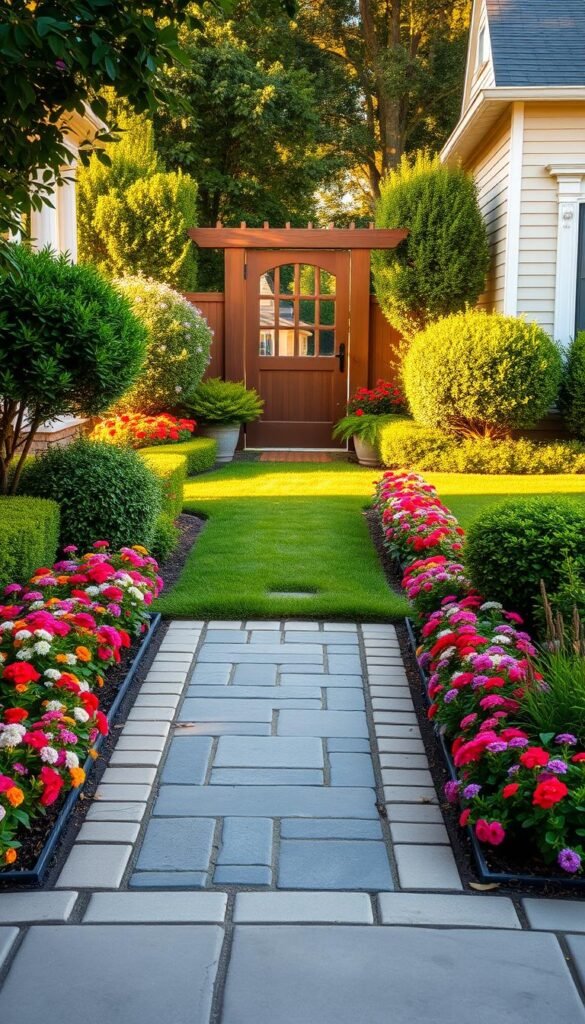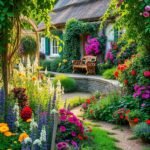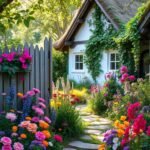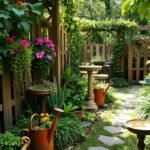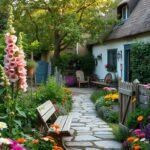Your outdoor space sets the tone for your entire property. A welcoming entrance doesn’t just catch the eye—it adds value and creates pride of ownership. Whether you’re refreshing tired flower beds or starting from scratch, smart design choices can turn your landscape into a neighborhood standout.
Balance beauty and practicality to craft a space that thrives year-round. Choose plants suited to your climate, and layer textures for visual depth. Even small updates, like adding pathway lighting or colorful annuals, make a big difference without straining your budget.
Think beyond aesthetics. Durable materials and native species reduce upkeep while supporting local ecosystems. Your design should reflect your personality—whether that means sleek modern lines or a cottage-style explosion of blooms.
Let’s explore how thoughtful design choices can elevate your property’s first impression. You’ll discover creative ways to maximize impact, blend functionality with style, and create an entrance that feels authentically yours.
Foundations of a Remarkable Front Yard Landscaping
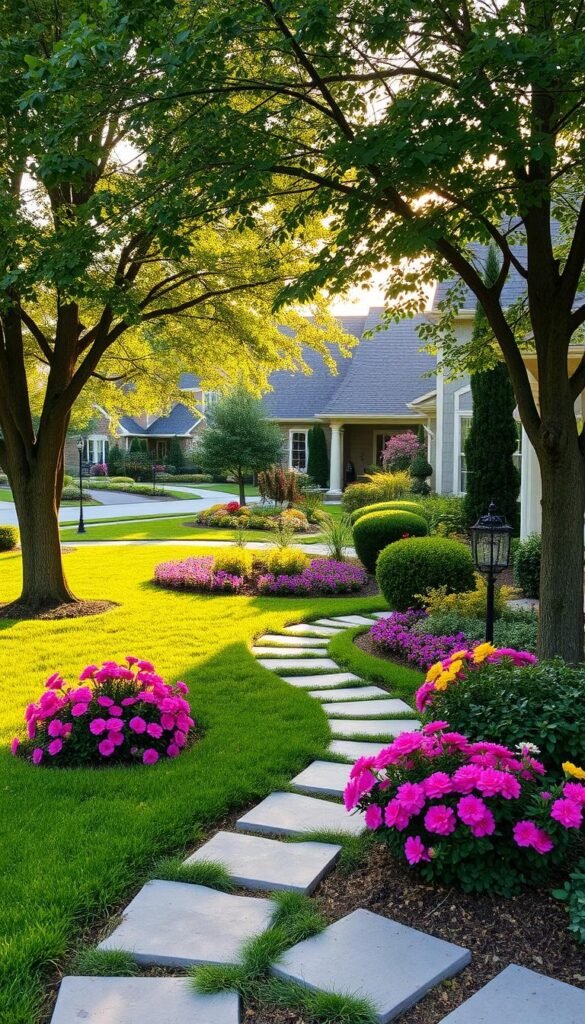
A well-planned front yard acts as your home’s handshake with the world. Start by studying your space like a detective – track sunlight patterns, test soil quality, and note where water pools after rain. These clues determine which plants will thrive and where hardscaping makes sense.
Smart yard landscaping begins with honest assessment. Walk your property at different times to spot problem areas. Does that corner get blasted by afternoon sun? Could those uneven pavers become tripping hazards? Jot down observations to shape your priorities.
| Factor | Impact | Quick Fix |
|---|---|---|
| Sunlight Exposure | Dictates plant selection | Use shade-loving hostas in dark corners |
| Soil Type | Affects drainage & nutrients | Mix in compost for clay-heavy earth |
| Drainage Patterns | Prevents erosion | Install French drains in soggy areas |
Match your landscaping design to your home’s architecture. A rustic cabin pairs beautifully with wildflower beds, while modern homes shine alongside geometric hedges. Remember: your yard should frame your house like a picture mat enhances artwork.
Create a phased plan that grows with your budget. Maybe start with foundational evergreens this year, add flowering perennials next spring, and install stone pathways when funds allow. This approach keeps projects manageable while building toward your vision.
Always factor in maintenance needs. Low-care options like ornamental grasses or mulch beds keep your space looking sharp without weekend marathons. Your future self will thank you for choosing beauty that doesn’t demand constant attention.
Choosing the Right Plants for a Vibrant Curb Appeal
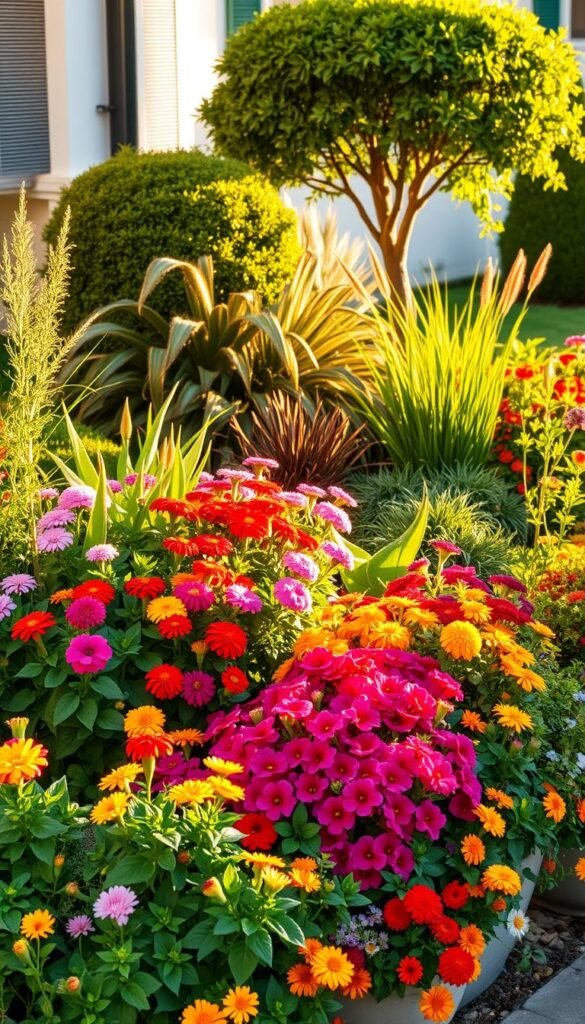
The plants you choose become living decor that evolves with the seasons. Start by mapping your yard’s sun patterns and soil type—these factors determine which species will thrive. Smart selections create year-round interest while cutting maintenance time.
Native Plants vs. Ornamental Selections
Local species like coneflowers or switchgrass adapt easily to your region’s weather. They need less water and resist pests naturally. Ornamental varieties, while eye-catching, often demand extra care. Balance both for visual drama that doesn’t drain your weekends.
| Type | Water Needs | Maintenance | Wildlife Value |
|---|---|---|---|
| Native | Low | Minimal | High |
| Ornamental | Moderate-High | Regular pruning | Low |
Tips for Long-Lasting Health and Beauty
Group plants with similar light and water needs. This prevents overwatering sun-lovers or drowning shade plants. Check nursery tags for mature sizes—crowded plants compete for nutrients and attract diseases.
Rotate blooming perennials with evergreens for nonstop color. Early bulbs give way to summer hydrangeas, followed by autumn sedum. For budget-friendly options, mix self-seeding annuals with durable shrubs.
Leave space between plants for air flow. Mulch beds to retain moisture and suppress weeds. Your choices today shape tomorrow’s curb appeal—pick wisely!
Crafting an Inviting Front Garden Entrance
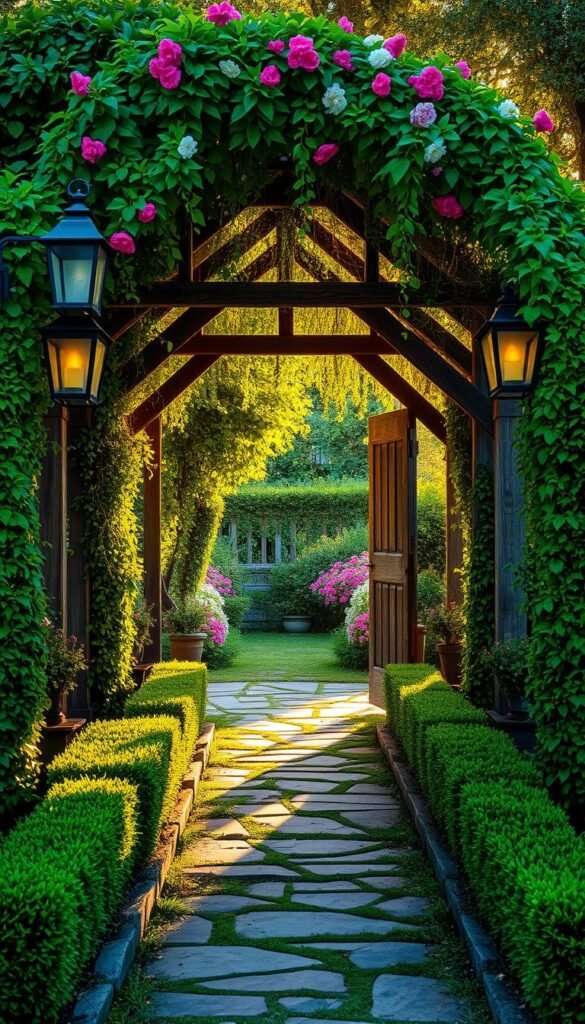
Your home’s entrance makes the first impression—make it count. A well-designed pathway acts like a red carpet, guiding guests while showcasing your style. Materials matter here: irregular bluestone with brick borders adds rustic charm, while sleek pavers suit modern homes.
Creating a Welcoming Entryway with Lighting
Lighting serves dual purposes—safety and ambiance. Solar-powered fixtures along walkways cast gentle glows without wiring hassles. For drama, uplight trees or architectural features. A soft wash of light on your door says “welcome” long after sunset.
Using Decorative Elements to Enhance Impact
Personal touches transform generic spaces into memorable ones. Try these ideas:
- Oversized planters flanking the door
- A vintage bench under blooming shrubs
- Metal artwork reflecting your hobbies
| Element | Visual Impact | Maintenance |
|---|---|---|
| Stone sculptures | High | Low |
| Water features | Moderate | Medium |
| Seasonal wreaths | Variable | High |
Scale matters most. A tiny bistro set gets lost beside a grand porch, while massive urns overwhelm cozy entries. Match decorative pieces to your space’s proportions for harmony that feels intentional.
Elevating Your Front Porch with Window Boxes and Planter Ideas
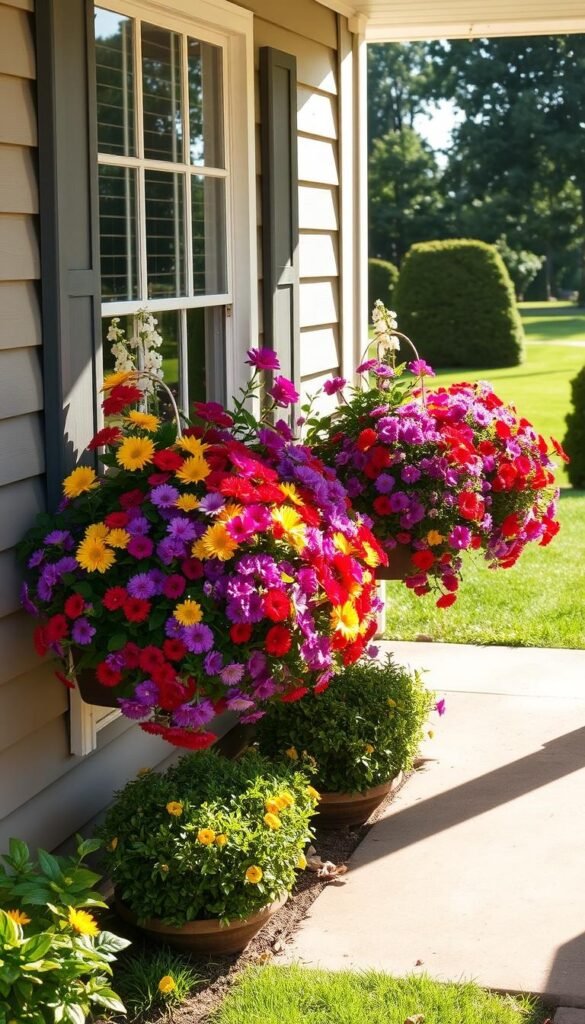
Container gardening brings vertical charm to your porch while solving space challenges. These movable displays let you splash color across your yard without digging up soil. Perfect for renters or anyone craving seasonal flexibility.
Match planter materials to your home’s personality. Weathered wood suits farmhouses, while sleek metal complements modern facades. Composite options withstand harsh weather, keeping your entry polished for years.
Group plants wisely in each container. Pair sun-loving petunias with drought-tolerant succulents, or shade-friendly ferns with impatiens. This ensures all flowers thrive under the same care routine.
Rotate displays like nature’s calendar:
- Spring: Tulips and pansies
- Summer: Geraniums and trailing ivy
- Fall: Chrysanthemums and ornamental cabbage
Drainage keeps roots healthy. Drill extra holes in store-bought planters and use potting mix, not garden soil. Water deeply when the top inch feels dry—containers dry faster than ground plantings.
With smart choices, your porch becomes a rotating gallery of living art. Even the smallest yard gains dimension when you think upward!
Enhancing Your Garden with Ornamental Grasses and Succulents
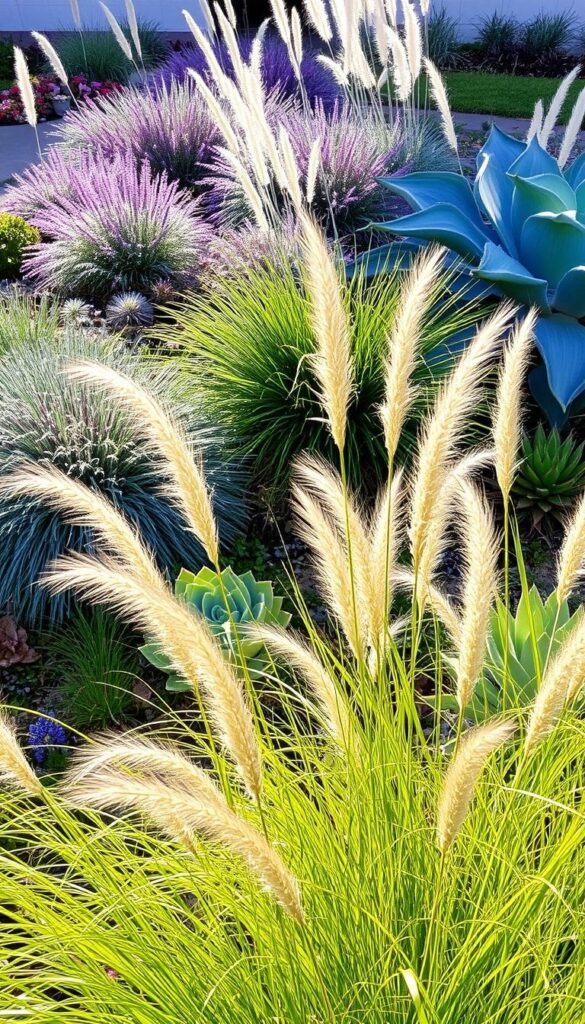
Low-maintenance greenery offers beauty without constant upkeep. Ornamental grasses and succulents deliver striking visual effects while surviving tough conditions. Their resilience makes them perfect for creating texture-rich displays that last through seasons.
Grasses like Carex and Hakonechloa add graceful movement to your space. Their feathery plumes catch sunlight and sway in breezes, creating living sculptures. Many varieties change colors as temperatures shift, offering autumn golds or winter bronzes without extra work.
Pair these with succulents like sedum for bold contrasts. Their fleshy leaves create geometric patterns that ground airy grass textures. Both plant types thrive in poor soil and need minimal watering once established—ideal for designing a cohesive look that stays vibrant during droughts.
Key benefits include:
- Deer resistance for worry-free growth
- Natural multiplication over time
- Year-round structure in garden beds or containers
Group taller grasses behind succulent groundcovers for layered depth. This combo works in sunny borders or shaded corners, adapting to your yard’s unique conditions. You’ll spend less time pruning and more time enjoying your evolving landscape.
Embracing a Natural and Organic Garden Style
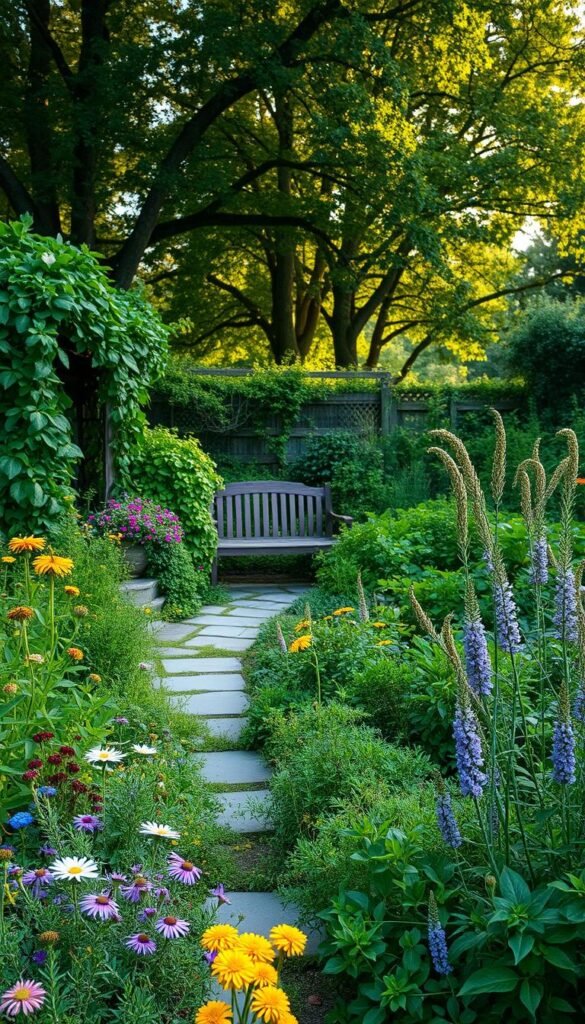
Nature thrives when room to breathe—organic garden design celebrates this truth. Instead of rigid hedges and manicured lawns, this approach lets plants grow freely while maintaining subtle structure. You’ll create spaces that feel alive yet intentional, blending beauty with ecological balance.
Cottage-style landscaping masters this balance beautifully. Think overflowing flower beds with lavender spilling onto walkways, or climbing roses framing a weathered bench. These designs appear spontaneous but require smart plant pairings. Choose perennials that bloom in sequence, ensuring color from spring through fall.
| Feature | Cottage Style | Modern Style |
|---|---|---|
| Plant Arrangement | Layered, mixed heights | Uniform, geometric |
| Maintenance Needs | Seasonal pruning | Weekly trimming |
| Wildlife Support | High (birds/bees) | Low |
Focus on native species like coneflowers or milkweed—they’re already adapted to your yard’s conditions. Their deep roots improve soil health and need less watering. Complement them with self-seeding annuals for pops of surprise color each year.
Organic gardening thrives on smart partnerships. Group plants that share sunlight needs and deter pests naturally. Marigolds protect tomatoes from nematodes, while basil enhances tomato flavor. These pairings reduce maintenance while boosting productivity.
Embrace imperfections—a leaning trellis or uneven stone path adds character. Your space becomes a living ecosystem, not a static display. Rain barrels and compost bins blend seamlessly into this style, cutting water bills and waste.
Hardscaping Essentials: Pathways, Paving, and Durable Materials
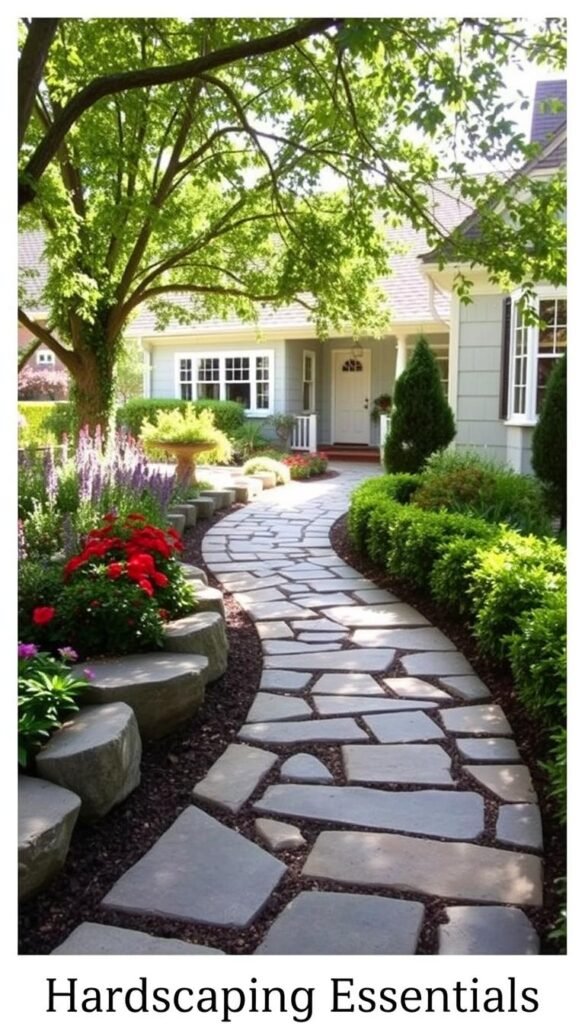
Durable surfaces create the framework that makes your greenery shine. Unlike plants that change with seasons, hardscaping provides permanent structure. Smart material choices ensure your investment lasts decades while complementing your home’s personality.
Choosing High-Quality Pavers for a Sleek Look
Modern slabs like Techo-Bloc’s Blu Grande Smooth offer clean lines and weather resistance. These stone alternatives mimic natural textures without constant sealing. Pair them with decomposed granite edges for contrast that softens geometric shapes.
Consider scale when planning walkways. Wide paths (4+ feet) accommodate side-by-side strolls, while narrow ones create intimate journeys. Always slope surfaces slightly away from your home to prevent water pooling.
Incorporating Retaining Walls for Added Structure
Retaining walls solve slope issues while adding visual drama. Stacked stone versions blend with traditional landscapes, while modular concrete blocks suit contemporary designs. For height over 3 feet, consult a professional to ensure proper drainage and stability.
| Material | Lifespan | Maintenance |
|---|---|---|
| Natural Stone | 50+ years | Annual sealing |
| Concrete Pavers | 25-40 years | Occasional power wash |
| Composite Decking | 15-25 years | Bi-annual cleaning |
Match hardscape colors to your home’s exterior. Warm terracotta tones enhance red brick facades, while cool grays complement modern metal siding. This creates cohesion between your landscape and architecture.
Bringing Life to Your Landscape with Captivating Water Features
Moving water transforms ordinary spaces into sensory experiences. A bubbling fountain or meandering stream adds dynamic energy while masking street noise. These elements become natural focal points, drawing the eye and inviting exploration.
Water features work harder than static decor. They attract pollinators like hummingbirds and create microclimates for moisture-loving plants. Even small tabletop fountains provide calming background sounds that enhance outdoor relaxation.
Match water elements to your space’s scale. Compact courtyards shine with wall-mounted cascades, while sprawling yards can host koi ponds edged with native rushes. Solar-powered pumps offer eco-friendly operation, and recirculating systems conserve resources.
Position features where you’ll enjoy them most—near seating areas or visible from windows. Use natural stones and aquatic plants to blend artificial components seamlessly into your design. With thoughtful placement, your water element becomes a living part of the landscape that evolves with the seasons.

